Wealth and Assets in Scotland 2006 - 2012
This report presents analysis of Scottish data from the Wealth and Assets Survey 2006-2012, with a particular focus on findings from the third wave of the survey, covering the period 2010/12. This updates the report Wealth and Assets in Scotland 2006-10, which was published in May 2014.
4. The Distribution of Components of Wealth in Scotland
This chapter presents an analysis of how the four components of total wealth - financial, pension, property and physical - are distributed in Scotland, by decile. Note that, in this chapter, deciles have been drawn on the basis of the distribution of the relevant component. The households in a given decile are therefore not necessarily the same households as in the equivalent decile for total wealth, discussed above.
4.1 Financial wealth
Financial wealth was the most unequally distributed of the wealth components. Chart 4.1 shows the distribution of financial wealth by decile.
Chart 4.1: Financial wealth by decile, values, 2010/12
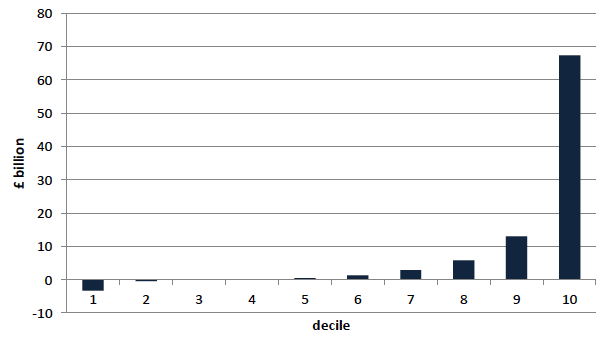
Source: Wealth and Assets Survey, ONS
This makes apparent the bottom 50 per cent of households, in terms of financial wealth, owned no financial wealth. Within that, the least wealthy 20 per cent of households had more debt than financial assets, shown in chart 4.1 as negative net financial wealth. The least wealthy 10 per cent of households in terms of financial wealth had £3.3 billion negative wealth - in short, they had more debt than decile 7 had net financial wealth (£2.9 billion).
As noted above, it is not necessarily the least wealthy households in terms of aggregate wealth that have the least financial wealth. It is, in fact, households in aggregate wealth deciles three and four who have the lowest mean net financial wealth. While these households do have net positive overall wealth, they are more likely to have debts outweighing savings when it comes to financial products.
The wealthiest 10 per cent of households in terms of financial wealth had positive financial wealth of 67.4 billion, 3.4 times the wealth of all other deciles combined.
As the net wealth of the bottom two deciles is negative, it is not possible to construct a ratio which includes this. Therefore, Chart 4.2 has excluded negative wealth to illustrate the distribution of financial wealth as percentages of total financial wealth. In this illustration, the bottom 50 per cent of households owned less than 1 per cent of financial wealth, with the wealthiest 10 per cent of households owning almost three quarters (74 per cent). Because of the adjustment made to produce this chart, the actual distribution of financial wealth in 2010/12 is more unequal still.
Chart 4.2: Financial wealth by decile, positive wealth values only 2010/12
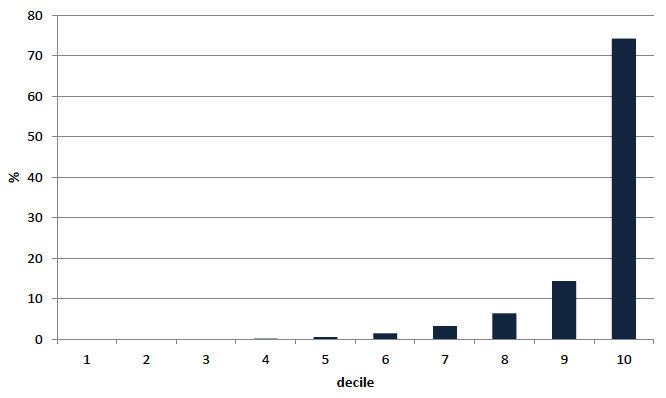
Source: Wealth and Assets Survey, ONS
Note: Negative wealth values were set to zero.
4.2 Private pension wealth
Chart 4.3 shows the distribution of private pension wealth. Private pension wealth was also highly concentrated amongst the wealthiest. The wealthiest 10 per cent in terms of pension wealth owned 55 per cent of private pension wealth, while the bottom 50 per cent owned less than 3 per cent. The least wealthy 20 per cent of households owned no pension wealth at all.
In terms of values of pension wealth, the wealthiest 10 per cent of households owned 22 times as much private pension wealth as the bottom 50 per cent of households combined, and 964 times as much as the bottom 30 per cent of households combined.
Chart 4.3: Pension wealth by decile, 2010/12
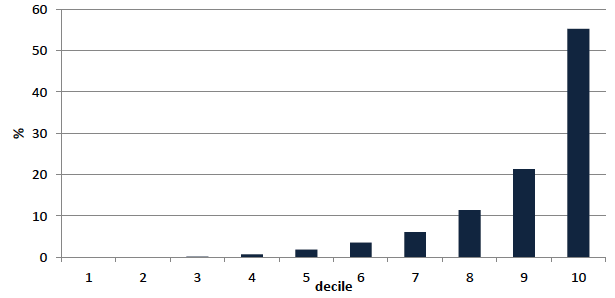
Source: Wealth and Assets Survey, ONS
Pension wealth, like other forms of wealth, builds up over a working lifetime. Households in the bottom half of the pension deciles may have little pension wealth because they have yet to build up a pension fund, including younger employees starting to pay into a pension. Pension contributions varied by age, with 58 per cent of people aged 35 to 55 paying into a private pension, compared to just 11 per cent of those aged 16 to 24.
However, the deciles without pension wealth will also include households where contributions to a private pension are not being made due to low incomes. Chart 4.4, overleaf, presents median private pension wealth and median household income by decile. This chart shows the median, or average pension wealth per household, and is different from Chart 4.3 which shows the aggregate pension wealth of all households within a given decile. It shows that households only start to accumulate substantial pension wealth from decile 4 onwards, at an income of £20,000.
In Scotland, 43 per cent of working age adults were paying into a private pension. For those contributing to a private pension scheme, around half contribute to an occupational defined benefits pension (current and retained pensions). The value of occupational defined benefits pensions, while showing a small increase between 2008/01 and 2010/12, remains below the values in 2006/08. The value of pensions held by the wealthiest 10 per cent fell between 2006/08 and 2010/12, resulting in a fall in pension inequality.
In 2010/12, 43 per cent of people made contributions to a private pension scheme, almost the same as in 2008/10 (42 per cent). The automatic enrolment for workplace pension schemes came into effect on 1 April 2012, with roll out across employers staged from this date until 2017. The impact of this policy is not measured within the wave three WAS data, as the data only covers the first two months of the scheme, but should start to become measurable in future WAS waves.
Chart 4.4: Median pension wealth and income by decile, 2010/12
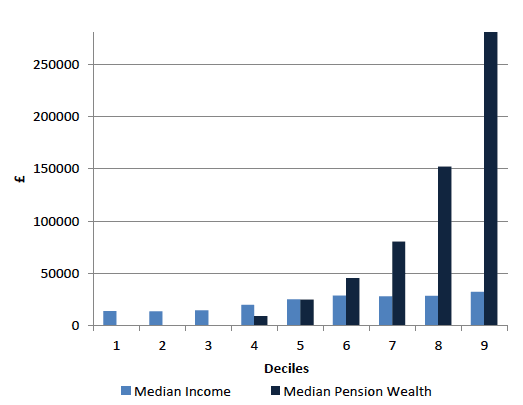
Note the tenth decile has been excluded from chart 4.4 to allow smaller values to display clearly.
4.3 Property wealth
Looking at property wealth, the least wealthy 30 per cent of households had no property wealth in 2010/12, with the least wealthy 10 per cent having net negative property wealth of 0.5 billion, and the second and third deciles having zero property wealth. After this point, the decile distribution for this component is somewhat flatter than for financial and pension, showing a more equal distribution.
It is important to note these figures are net property wealth - the value of the property minus the value of the outstanding mortgage. For families at earlier life stages, net property value will be lower as property is mortgaged. By pensionable age, many households will own their property outright, and so net property wealth is the value of the property. For older households, the net property wealth will also capture any increase in property values over their period of ownership.
As will be shown in the next chapter, the least wealthy 30 per cent in terms of total wealth are substantially less likely than the population as a whole to own property, and any ownership of property in this group is likely to be on a mortgage.
Chart 4.5 shows the distribution of property wealth treating negative values as zero to illustrate the distribution of property wealth as percentages of total property wealth. This shows that the wealthiest 10 per cent of households owned 43 per cent of property wealth, while the bottom 50 per cent owned just 6 per cent. Note that property wealth also includes land ownership. Land ownership is more unequal than other forms of wealth. Estimates suggest more than half of land in Scotland is owned by fewer than 500 individuals[2].
Chart 4.5: Property wealth by decile, 2010/12
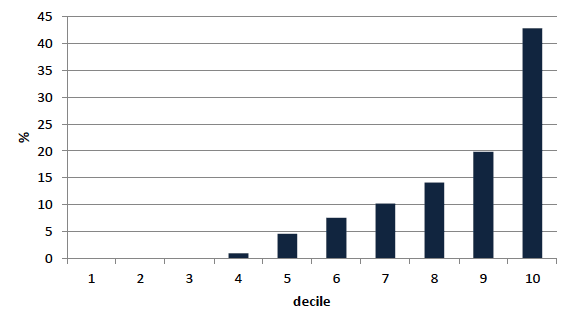
Source: Wealth and Assets Survey, ONS
Note: Negative wealth values were set to zero.
The wealthiest 10 per cent in terms of property wealth owned eight times as much property wealth as the bottom 50 per cent of households combined, and 56 times as much as the least wealthy 40 per cent combined. Comparisons with the least wealthy 30 per cent are not meaningful, as this group has negative net property wealth.
4.4 Physical wealth
Physical wealth was the most equally distributed component of wealth, but still shows high inequality in ownership.
Chart 4.6 shows the distribution of physical wealth across the population. The wealthiest 10 per cent in terms of physical wealth owned 33 per cent of physical wealth, twice as much as the second wealthiest decile (16 per cent) and 1.7 times as much as the bottom 50 per cent of households combined (20 per cent).
The much lower level of inequality is reflected in the ratios between the wealthiest 10 per cent and other groups. The wealthiest 10 per cent owned twice as much physical wealth as the least wealthy 50 per cent of households, three times as much as the least wealthy 40 per cent, and four times as much as the least wealthy 30 per cent.
Chart 4.6: Physical wealth by decile, 2010/12
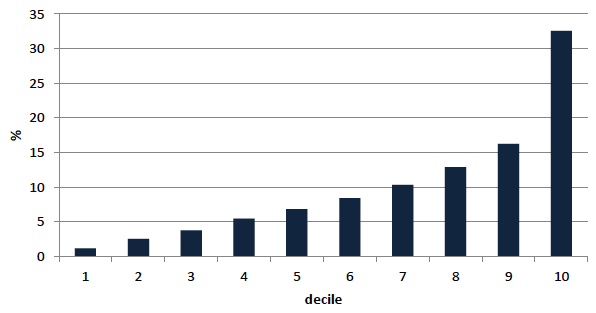
Source: Wealth and Assets Survey, ONS
4.4.1 Wealth inequality as measured by Gini coefficients
The final section in this chapter discusses the Gini coefficient, a commonly used measure of inequality, in relation to the components of wealth. A Gini coefficient of 0 represents perfect equality, while a coefficient of 1 represents perfect inequality, i.e. all wealth being owned by a single person.
Table 3.1 shows the Gini coefficients for total wealth and the four wealth components in 2006/8, 2008/10 and 2010/12. The Gini coefficient for wealth overall was 0.61 in 2010/12. Total wealth became slightly more equally distributed over time, with the Gini coefficient decreasing from 0.63 in 2008/10 and 66 in 2006/08. This reduction was largely driven by a fall in the value of private pension wealth owned by the wealthiest 10 per cent of households. There was a small increase in the value of physical wealth owned by the least wealthy 30 per cent which reduced inequality in physical wealth ownership.
Table 4.1 Gini coefficients by wealth component, 2006/08 - 2010/12
| 2006/08 |
2008/10 |
2010/12 |
|
|---|---|---|---|
| Property wealth |
0.65 |
0.64 |
0.64 |
| Financial wealth |
0.90 |
0.89 |
0.93 |
| Physical wealth |
0.47 |
0.48 |
0.45 |
| Private pension wealth |
0.79 |
0.77 |
0.74 |
| Total household wealth |
0.66 |
0.63 |
0.61 |
Source: Wealth and Assets Survey, ONS
Looking at components of total wealth, the Gini coefficients confirm the findings discussed in the sections above:
- Financial wealth was the most unequally distributed, with a Gini coefficient of 0.93, and the inequality of this component increased between 2006/08 and 2010/12.
- Physical wealth was the least unequally distributed with a coefficient of 0.45. Inequality in this component has decreased slightly between 2006/08 and 2010/12 due to an increase in the value of physical wealth owned by the least wealthy households.
- Pension wealth had a Gini coefficient of 0.74, and inequality in this component has decreased since 2006/08 and 2010/12, due to a fall in the value of pensions owned by the wealthiest 10 per cent.
- Property wealth had a Gini coefficient of 0.64 in 2010/12, which was largely unchanged over between 2006/08 and 2010/12.
Contact
Email: Stephen Smith
There is a problem
Thanks for your feedback